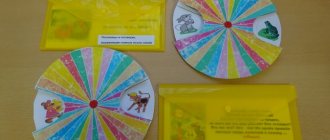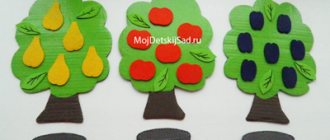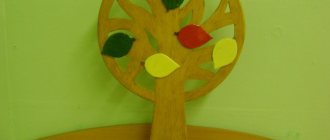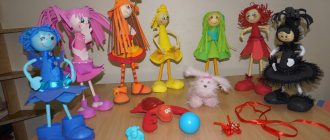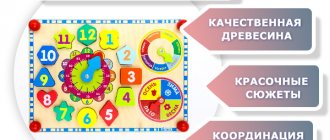MAGAZINE Preschooler.RF
Stages of conducting didactic games for the speech development of children in the senior group.Moreva Olga Ivanovna
Preparatory stage
1. Games for the development of the phonetic-phonemic aspect of speech
"Japanese typewriter"
The game is aimed at reproducing a rhythmic pattern (rhythm) when clapping, tapping or making a sound on any instrument (tambourine, rattle, xylophone).
"Let's play a fairy tale"
The adult invites the child to remember the fairy tale “The Three Bears” . Then, changing the pitch of his voice, he asks to guess who is speaking: Mikhailo Ivanovich (low voice), Nastasya Filippovna (medium pitch voice) or Mishutka (high voice). The same replica is pronounced alternately in a voice of different pitches, in three versions:
-Who was sitting on my chair?
- Who ate from my cup?
-Who slept in my bed?
- Who was in our house? And so on.
"Broken phone"
Goal: to develop auditory attention in children.
Game rules. The word must be conveyed in such a way that children sitting nearby cannot hear. Who conveyed the word incorrectly, i.e. ruined the phone, moves to the last chair.
Game action: whisper a word into the ear of the player sitting next to you.
Progress of the game. Children choose a leader using a counting rhyme. Everyone sits on chairs placed in a row. The presenter quietly (in the ear) says a word to the person sitting next to him, who passes it on to the next person, etc. The word must reach the last child. The presenter asks the latter: “What word did you hear?” If he says the word suggested by the presenter, then the phone is working. If the word is wrong, the driver asks everyone in turn (starting with the last) what word they heard. This way they will find out who made a mistake, “damaged the phone” . The offender takes the place of the last in the row.
"Traffic light"
The adult gives the child two circles - red and green and offers a game: if the child hears the correct name of what is shown in the picture, he must raise the green circle, if the wrong one - red. Then he shows the picture and loudly, slowly, clearly pronounces the sound combinations:
- Baman
- Paman
- Banana
- Banam
- Vitamin
- Mitanin
- Phytamine
- wavan
- davan
- bavan
- vanan
- vitanin
- Mitavin
- fitavin
- album
- ibom
- anbom
- abbom
- cell
- bootie
- cage
- alp
- alm
- alny
- problem
- project
- kvetka
- tlekta
2. Games for the development of the lexical side of speech (formation of a dictionary)
“We are moving to a new apartment”
Goal: to teach children to distinguish between objects that are similar in purpose and similar in appearance, to help them remember their names; activate the appropriate vocabulary in children's speech.
Game material:
- Subject pictures (paired): cup-glass, mug-cup, butter-sugar bowl, teapot-coffee pot, saucepan-frying pan, scarf-kerchief, hat-cap, sundress dress, sleeveless sweater, shorts, knee-high socks, stockings-socks, gloves-mittens, shoes-sandals, slippers-sandals, backpack-briefcase, chandelier-table lamp.
- Boxes for folding pictures.
Game progress: 6 children play. The teacher gives each child 2-3 pairs of pictures, for example: a cup-glass, a scarf-kerchief, a backpack-briefcase. He says: “Children, we got a new apartment. We need to collect all our things and pack them for moving. First I will pack the dishes. You will help me. Give me only the thing that I name. Be careful - many things look similar. Do not confuse, for example, a mug with a cup, or a teapot with a coffee pot. I will put the collected dishes in a blue box .
The teacher names one item from each pair, for example a coffee pot. If the child makes a mistake (shows a teapot), the picture remains with him. By the end of the game, the children should not have a single picture left. The loser is the one who has the pictures left. Then, to activate the corresponding vocabulary in the children’s speech, the teacher invites one child to take the collected pictures out of the box and say what he got, and the rest to name the object paired with the one being presented.
"Tops-Roots"
Didactic task: Exercise children in classifying vegetables (based on the principle: what is edible - the root or the fruit on the stem).
Game rules. You can only answer in two words: tops and roots. Whoever makes a mistake pays forfeit.
Game action. Playing forfeits.
Progress of the game. The teacher clarifies with the children what they will call tops and what roots: “We will call the edible root of a vegetable roots, and the edible fruit on the stem - tops .
The teacher names a vegetable, and the children quickly answer what is edible in it: the tops or roots. The one who makes a mistake pays a forfeit, which is redeemed at the end of the game.
The teacher may offer another option; he says: “Tops - and the children remember vegetables whose tops are edible .
"Fruits vegetables"
Purpose of the game: differentiation of similar concepts.
Progress of the game. At the beginning of the game, the leader reminds the children which plants we call fruits and which vegetables. For fruits, select the picture “Garden” , and for vegetables – “Vegetable Garden” . These pictures are laid out on different edges of the table. Object pictures depicting fruits and vegetables lie on the table in a stack, pictured down. In turns, children take one picture from the pile, name it, and also explain which group it belongs to. The explanation must be complete: “A tomato is a vegetable because it grows in the garden . If the child gave the wrong answer, the picture is returned to its place, and if the child correctly named the picture and attributed it to the desired concept, he takes it for himself. The game ends after the children have all the pictures. The one with the most pictures wins.
The game “Fruits and Berries” is played in the same way, only before the game these concepts are clarified and other pictures-symbols are selected: a bush for berries and a tree for fruit.
"Housewarming"
Purpose: differentiation of the concepts of “clothing” and “shoes” .
Progress of the game. The following game situation is created: “Katya’s doll is having a housewarming party. She needs to pack her things to move to a new apartment. Help her arrange her things correctly so that she can easily find all her dresses and shoes in her new place. We will put clothes in one box, and shoes in another . Then the child is given two sets of object pictures and two boxes, each with its own symbol: a dress for clothes, boots for shoes.
"Blurred Letter"
Purpose: To practice composing common exercises.
Material. Teddy bear.
Organization. Educator:
— The little bear received a letter from his brother. But the rain blurred some words. We need to help him read the letter. Here is the letter: “Hello, Mishutka. I'm writing to you from the zoo. Once I didn’t listen to my mother and got so far that... I wandered through the forest for a long time and... Coming out into a clearing, I fell... I fell into a hole because... It was so deep there that... Hunters came and... Now I I live in... We have a playground for... There is a lot in the playground for young animals... We play with... They are looked after... They love us because... A trainer from … Goodbye. Toptygin" .
While reading the letter, the teacher uses intonation to encourage the children to complete the sentences.
| Next > |
